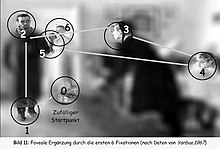
Back حركة العين Arabic Moviment ocular Catalan Oční pohyb Czech Augenbewegung German Movimiento ocular Spanish Mouvement oculaire French תנועות עיניים HE Kretnje očiju Croatian Movimento oculare Italian Движение глаз Russian

Eye movement includes the voluntary or involuntary movement of the eyes. Eye movements are used by a number of organisms (e.g. primates, rodents, flies, birds, fish, cats, crabs, octopus) to fixate, inspect and track visual objects of interests. A special type of eye movement, rapid eye movement, occurs during REM sleep.
The eyes are the visual organs of the human body, and move using a system of six muscles. The retina, a specialised type of tissue containing photoreceptors, senses light. These specialised cells convert light into electrochemical signals. These signals travel along the optic nerve fibers to the brain, where they are interpreted as vision in the visual cortex.
Primates and many other vertebrates use three types of voluntary eye movement to track objects of interest: smooth pursuit, vergence shifts[1] and saccades.[2] These types of movements appear to be initiated by a small cortical region in the brain's frontal lobe.[3][4] This is corroborated by removal of the frontal lobe. In this case, the reflexes (such as reflex shifting the eyes to a moving light) are intact, though the voluntary control is obliterated.[5]
- ^ Pierrot-Deseilligny, Charles; Milea, D.; Muri, R. M. (2004). "Eye movement control by the cerebral cortex". Current Opinion in Neurology. 17 (1): 17–25. doi:10.1097/00019052-200402000-00005. PMID 15090873. S2CID 18569409.
- ^ Krauzlis RJ (April 2005). "The control of voluntary eye movements: new perspectives" (PDF). The Neuroscientist. 11 (2): 124–37. CiteSeerX 10.1.1.135.8577. doi:10.1177/1073858404271196. PMID 15746381. S2CID 1439113. Archived from the original (PDF) on 17 July 2006. Retrieved 18 February 2006.
- ^ Heinen SJ, Liu M (September–October 1997). "Single-neuron activity in the dorsomedial frontal cortex during smooth-pursuit eye movements to predictable target motion". Vis Neurosci. 14 (5): 853–65. doi:10.1017/s0952523800011597. PMID 9364724.
- ^ Tehovnik EJ, Sommer MA, Chou IH, Slocum WM, Schiller PH (April 2000). "Eye fields in the frontal lobes of primates" (PDF). Brain Res. 32 (2–3): 413–48. doi:10.1016/s0165-0173(99)00092-2. hdl:10161/11752. PMID 10760550. S2CID 4467996.
- ^ "Sensory Reception: Human Vision: Structure and function of the Human Eye" Encyclopædia Britannica, 1987
© MMXXIII Rich X Search. We shall prevail. All rights reserved. Rich X Search